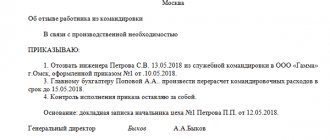Today, a job description is an optional document, but employers, as a rule, continue to draw it up. The reason for this is that such a document somewhat simplifies the understanding of the responsibilities of a specific staff unit, and also simplifies the relationship between employer and employee. In conflict situations, the instructions help to prove that one of the parties is right. In the article we will look at how, if necessary, to make changes to the instructions, as well as how to draw up an order to make changes to the job description.
General information
When drawing up a contract, the parties stipulate the employee’s labor function. Its content consists of specific duties for the position, the list of which corresponds to the staffing table. As a rule, they are fixed in the job description. This document is an annex to the agreement.
Changes to the job description are made by agreement of the parties if the adjustments affect the content of the job function. The legislation provides for certain exceptions to this requirement (Articles 72.2, 73 of the Labor Code), however, they relate to specific situations to which the general rules do not apply.
When making changes to the job description, a separate written agreement must be concluded with the employee. Otherwise, the new edition of the local document cannot be applied. This rule also applies to situations where a revision of the instructions entails a change in other terms of the contract that are not related to the labor function.
How often can changes be made?
This document is usually generated immediately after the registration of the enterprise for each position of the staffing table for an indefinite period. In the future, as practice shows, most often the job description undergoes changes for the following reasons: changes in the structure of the organization (reduction or increase in divisions and departments), reduction of personnel, redistribution of labor functions in order to optimize the work of employees. Also, adjustments to job descriptions may be required when amendments are made to legislation.
Changes to the job description can be made as many times as you like.
However, if the changes affect a large volume of the document, it is more advisable, instead of editing the old instructions, to create and approve a new one.
Updates and additions to the job description (sample) are made when adjusting the scope of job responsibilities, changes in technological and organizational working conditions. At the legislative level, the procedure by which changes are made to the job description is not regulated. Accordingly, organizations have the right to independently draw up a certain procedure. After that, the established regulations should be fixed in a local document.
Features of document development
Labor legislation does not require employers to have job descriptions for employees. However, these documents are developed at all enterprises. Their presence helps prevent possible controversial issues.
Conflicts, for example, may arise over a specific job that an employee must perform. The reason for such disputes is the ambiguity in the designation of responsibilities. Often such conflicts end in termination of the contract. However, employees in such situations go to court and successfully challenge the employer’s actions. Such consequences can be prevented by competently drawing up a job description.
When developing the document, it is necessary to take into account the information of the Unified Qualification Directory for Positions and Professions. However, the list of functional (job) responsibilities does not have to be fully consistent with it. Each employer draws up instructions for staff taking into account the specifics of the enterprise’s activities.
Nuances of adjustment
The Labor Code does not have a clear procedure for making changes to the job description. Therefore, an enterprise can develop its own rules. But they should not, however, contradict the principles of labor legislation. The established rules for making changes to job descriptions are recorded in a local document.
When adjusting instructions, you should consider:
- The method of execution of a document subject to change. The instruction can be an appendix to the contract or a separate (independent) document.
- Specifics of adjustments. It is necessary to determine whether the changes concern the essential terms of the contract.
If the instruction is drawn up as an annex to the contract, then it acts as an integral part of it. Accordingly, any adjustments are accompanied by changes in the terms of the contract. In this case, the nature of the changes will not matter. If this rule is not followed, the employee may refuse to perform new duties.
If the instruction is a separate document, and the adjustments do not concern the essential terms of the contract, one must proceed from the fact that the actual labor functions of the employee remain the same. Accordingly, the employer has the right to specify certain responsibilities without taking into account the opinion of the employee himself.
Whose autographs should appear on the document?
Since all orders are issued on behalf of the director, he must be the first to sign this order. In addition to him, the form must indicate all the persons to whom he is related, as well as those employees of the enterprise who are responsible for the execution of the order. It should be said that in some cases, employees of an organization can leave their autographs about familiarization not directly in the order itself, but in a separate act or statement (this is especially true in large companies with a large number of personnel). A stamp in a document is not a strictly mandatory condition for its authenticity, but if there is an indication of its use in the company’s regulations, then the order should still be endorsed using a stamp.
Action plan
Changes to the job description are carried out as follows:
- A draft of a new version of the document is being developed. You can also draw up an act in which you add a list of adjustments to the current instructions.
- A new edition of the document is approved. To do this, an order is drawn up to amend the job description or to approve a new edition.
- The employee is provided with a new document for review and signature.
This procedure applies if the instruction is an annex to the contract, and the adjustments do not concern changes in the essential terms of the contract. For example, an employee may be assigned to perform duties specified in the characteristics of other positions. At the same time, they do not require special skills, knowledge or other qualifications. In this case, changes to the job description will not affect the labor function. The employee's consent is not required in such situations.
Making changes to the job description: sample order
The order of the head of the enterprise is a mandatory administrative document. Its preparation is necessary in all cases affecting the activities of the organization. This document must comply with the requirements provided for in labor legislation for local acts.
A sample order to amend a job description contains the following information:
- Date, compilation number.
- Business name.
- Document's name.
- Details of the instruction or order for its approval in the original edition.
- Contents of changes. It is necessary to indicate which clauses are no longer valid, are set out in a new edition, or which conditions supplement the document.
- Effective date of the changes. This may be a specific calendar date or point in time (for example, from the date of introduction to employees).
- Full name and position of the HR department employee responsible for informing the employee about the changes adopted.
How to account and store
If you have any questions, you can consult for free via chat with a lawyer at the bottom of the screen or call by phone (consultation is free), we work around the clock.
The order, as one of the main documents regulating the activities of the organization, is subject to certain accounting. To do this, information about it must be entered in a special accounting journal, where it is enough to make a note about the date of its issue and number. After this, the completed form and signed by all interested parties should be filed in the same place where other similar papers are already stored. Here it must be available for the period established by law or for the period prescribed in the accounting policy of the enterprise.
Refusal of the employee to read the instructions
In such situations, the employer draws up an act in which witnesses (at least two) from among the company’s employees sign.
Often in practice, the manager sends a new version of the instructions to the employee by mail. The shipment is issued in the form of a registered letter with an inventory and notification. In this case, the employee will be considered to have read the new version of the instructions.
It must be said that the fact of an employee’s refusal cannot be regarded as a disciplinary offense. The employer will have grounds for liability if the employee subsequently evades the performance of his duties in accordance with the adopted document. The employee’s disagreement with any points of the instruction is not considered grounds for its cancellation.
For what reasons does a document change?
There may be many reasons why the content of a document may need to be changed. But there are a number of most common circumstances:
- Innovations in the structure of the enterprise - the abolition of any departments or their expansion.
- Adjustments to the functionality of employees - expansion or narrowing of powers.
- Making adjustments to the legislation of the Russian Federation, entailing editing of the document.
- Purchase of new special equipment with which the company’s employees will have to work.
- Introduction of a new permanent work schedule.
- Changing the name of the company or its field of activity.
- Less often - private situations with a specific employee.
In addition to the reasons listed above, there is one more, often found in young companies. Instructions are drawn up immediately after business registration, and the actual state of affairs may be different.
Features of adjustments
What changes can be considered affecting the labor function? Its description must comply with the provisions of Article 15 of the Labor Code. The description states:
- Position (specialty, profession) and qualifications.
- The type of activity that the employee must perform.
It is necessary to take into account that the absence of an indication of a position in the staffing table cannot be considered an obstacle to the recognition of legal relations as labor relations.
It is possible to establish a different job function or significantly change the previous one with the consent of the employee. In fact, such actions are considered as transferring the employee to another job. Without the consent of the person, a function can be changed only temporarily and in cases determined by the Labor Code.
Adjustments of duties within the framework of work activities for a specific position change the work function only if they actually lead to the implementation of activities in another position.
Authorization
NOTE:
We will only talk about cases where the job description is approved as a local act. If it is formalized as part of an employment contract, then in the event of a change in duties, it is necessary to obtain the employee’s consent. When can job responsibilities be changed without the employee’s consent?
If the job description is approved as a separate document and not an appendix to the employment contract, the employer has the right to change it at his own discretion (Article 8 of the Labor Code of the Russian Federation, appeal ruling of the Astrakhan Regional Court dated June 27, 2012 in case No. 33-1932/2012).
You can reduce or increase the scope of responsibilities, as well as specify them. The employee's consent is not required for this.
But it is important that the labor function remains the same.
If you completely change the content of the job description, the court will recognize that the old and new editions of the document contain different job functions. Such a change without the employee’s consent is illegal; a transfer must be formalized (ruling of the Primorsky Regional Court dated March 26, 2014 in case No. 33-2307).
There is no single approach to the question of what is considered a labor function. Most often, courts recognize that this is not only the title of the position, but also its content, that is, the nature of the duties. Changing a job function can only be done through a transfer, which always requires the consent of the employee (part one of Article 15, paragraph 3 of part two of Article 57, part one of Article 72.1 of the Labor Code of the Russian Federation).
For example, it is impossible to approve a new job description according to which an employee who performed the functions of a marketer will be involved in accounting.
The court decides in each specific case whether the adjustment of duties in the job description entails a change in the job function. As a result, he finds out whether it is necessary to obtain the employee’s consent to such a change (decision of the Constitutional Court of the Russian Federation dated September 25, 2014 No. 1853-O).
Increased responsibilities
The employer has the right to increase the scope of responsibilities for the position held by the employee. This will not be a change in the labor function (decision of the Moscow City Court dated July 2, 2013 No. 4g/1-5084).
It is safe to change functionality taking into account accepted professional standards and qualification reference books. If the job description includes an obligation that is in one of these documents, then the court will most likely side with the employer (appeal ruling of the Astrakhan Regional Court dated May 22, 2013 in case No. 33-466/2013). The employer’s right to expand the range of responsibilities of employees is enshrined in paragraph 4 of the Qualification Handbook, approved by Resolution of the Ministry of Labor of Russia dated August 21, 1998 No. 37.
It is risky to include in the job description actions that relate to another job function, so as not to pay for additional work. If the employee refuses to perform such duties, the court may find this lawful. For example, cleaning premises is not included in the job function of a nurse, even if such a duty was included in the job description (appeal ruling of the Samara Regional Court dated 07/09/2014 No. 33-6615/2014). In this case, you need to enter into an agreement with the employee to perform additional work for another job function and agree with him on the amount of additional payment (Articles 57, 60.2, 72, 151 of the Labor Code of the Russian Federation).
The risk of controversial situations can be reduced by using double job titles in the staffing table, for example, “delivery driver” or “accountant-cashier”. This will confirm that the employee’s responsibilities include a variety of tasks. Some courts recognize that responsibilities for two job functions can be included in a job description. Thus, in one case, the court found that the security guard’s instructions lawfully included the obligation to clean the territory. The employment contract included a salary that took into account the additional job function, which means there was no combination of positions (ruling of the Vladimir Regional Court dated June 16, 2011 No. 33-2050/2011).
Reduced responsibilities
Organizations often reduce workers' responsibilities in order to reduce their pay. According to the courts, a reduction in the scope of job responsibilities, as a rule, does not mean a change in the employee’s labor function (appeal ruling of the Yaroslavl Regional Court dated 07/19/2012 in case No. 33-3711/2012, appeal ruling of the Sverdlovsk Regional Court dated 02/11/2014 in case No. 33 -1893/2014).
However, if the employee loses the opportunity to work and the employer declares him idle, the court will recognize such a change in the instructions as illegal (decision of the Presnensky District Court of Moscow dated June 17, 2015 No. 2-3005/2015). If there is no longer a need for a labor function, the employer has the right to make reductions and dismiss the employee with payment of the required compensation.
Clarification of responsibilities
The employer has the right to specify what actions are included in a particular duty. In addition, you can clarify the list of programs or equipment that the employee uses at work, and detail daily operations and procedures. There is no increase or decrease in the amount of work. Such clarification of job responsibilities does not lead to a change in the labor function and other terms of the employment contract (appeal ruling of the Omsk Regional Court dated January 14, 2015 in case No. 33-16/2015, appeal ruling of the Astrakhan Regional Court dated July 2, 2014 in case No. 33-1947/ 2014).
How to make changes to a job description
If the job description was drawn up as a separate document, then it is enough to approve it in a new edition and familiarize the employee with the amendments for signature (paragraph 10, part two, article 22 of the Labor Code of the Russian Federation, letter of Rostrud dated October 31, 2007 No. 4412-6). If the employee agrees to the changes, there will be no problems.
Often the employee is not satisfied with the changes, and he refuses to sign the new version of the job description. In this case, read the document out loud and draw up a statement in any form stating that the employee refused to read the instructions. Draw up the act in the presence of two or three witnesses. Further actions will depend on whether the scope of work changes or responsibilities are clarified.
The employee's workload has changed
If duties have been increased or decreased and this entails a change in the terms of the employment contract, then the employer must apply the procedure provided for in Article 74 of the Labor Code. It is possible that changes do not affect the terms of the contract, but the scope of work changes. If the employer admits that he will have to part with the employee under paragraph 7 of part one of Article 77 of the Labor Code, Article 74 of the Labor Code must also be applied. In this case, the courts do not find out how the job description was drawn up - as a separate document or part of an employment contract (appeal ruling of the Chelyabinsk Regional Court dated April 28, 2014 in case No. 11-4607/2014).
NOTE:
It is risky to motivate a reduction in responsibilities and a reduction in wages by a financial crisis, a drop in sales, etc. Courts usually do not recognize such reasons as an organizational change (decision of the Sverdlovsk Regional Court dated February 20, 2013 in case No. 33-1190/2013).
It is necessary to prepare evidence in case of a legal dispute.
You will have to prove that:
– organizational or technological working conditions have changed;
– the previous terms of the employment contract cannot be preserved;
– there was no change in work function.
The law does not clearly define what organizational or technological changes are.
There is an approximate list (Article 74 of the Labor Code of the Russian Federation, paragraph 21 of the Resolution of the Plenum of the Supreme Court of the Russian Federation dated March 17, 2004 No. 2).
In itself, reducing or increasing the amount of work performed will not be such a change.
Main organizational and technological changes under which working conditions can be changed
Organizational changes
– change in organizational structure;
– new work and rest regimes have been introduced;
– labor standards have been revised;
– loads have been redistributed between departments and employees;
– refusal of certain types of activities.
Technological changes
– new machinery and equipment were introduced;
– transition to new production technology;
– improvement of working conditions based on the results of a special assessment;
– production of new types of products has begun.
The organization must notify the employee in writing about upcoming changes to the terms of the employment contract and their reasons no later than two months in advance and offer a transfer to suitable vacancies.
If the employee agrees with the changes, then an additional agreement to the employment contract is concluded with him (Article 72 of the Labor Code of the Russian Federation).
If the employee refuses to work under the new conditions and cannot be transferred to another position, the employer has the right to terminate the employment contract with him after two months (Article 74, paragraph 7 of Part 1 of Article 77 of the Labor Code of the Russian Federation).
If an employee is fired for refusing to work under new conditions, then he is paid severance pay in the amount of two weeks’ average earnings (part three of Article 178 of the Labor Code of the Russian Federation).
Clarification of employee responsibilities
If the functionality in the new edition of the job description is only specified, but the scope of work has not changed, first you need to explain this to the employee. If it is not possible to convince him to fulfill his duties, the employer has the right to apply disciplinary sanctions for refusal to carry out the instructions (Article 192 of the Labor Code of the Russian Federation). In the future, you can dismiss an employee for repeated failure to fulfill duties under paragraph 5 of part one of Article 81 of the Labor Code (appeal ruling of the Khabarovsk Regional Court dated 04/18/2014 in case No. 33-2222/2014, determination of the Sverdlovsk Regional Court dated 08/30/2012 in case No. 33- 10833/2012).
NOTE:
If an employee performs the duties of a temporarily absent colleague without being released from his main job, he is entitled to additional payment. Its size is established by agreement of the parties, taking into account the content of additional work (parts one and two of Article 151 of the Labor Code of the Russian Federation).
The complexity of the work and the volume of work of the deputy during the absence of the manager increase. Therefore, he needs to pay extra (decision of the Supreme Court of the Russian Federation dated March 11, 2003 No. KAS03-25, resolution of the Arbitration Court of the North-Western District dated November 16, 2016 No. F07-9908/2016).
There is also the opposite opinion. If the obligation to replace another employee during his absence is provided for in the employment contract or job description of the deputy, then the employer is not obliged to pay him extra for replacing the manager (letter of the Ministry of Health and Social Development of Russia dated March 12, 2012 No. 22-2-897, letter of Rostrud dated May 24, 2011 No. 1412 -6-1).
If the second position is chosen, it is necessary to prepare evidence that the deputy’s salary takes into account the increased amount of work during the replacement of the manager.
The courts recognize that clarification of job responsibilities for the position held does not constitute a change in the terms of the employment contract. Therefore, it is not necessary to notify the employee two months in advance (appeal ruling of the Supreme Court of the Republic of Bashkortostan dated July 3, 2014). Moreover, applying the procedure provided for in Article 74 of the Labor Code is dangerous in this case. Since the terms of the contract remain unchanged, the court may recognize the dismissal of an employee under paragraph 7 of part one of Article 77 of the Labor Code as illegal and reinstate him at work (appeal ruling of the Omsk Regional Court dated April 29, 2015 in case No. 33-2668/2015).
Normative base
1. Part one of Art. 15, para. 3 hours second art. 57, part one, art. 72.1 of the Labor Code of the Russian Federation will help you understand that the labor function is the title of the position and the nature of the employee’s duties
2. Articles 8, 22 of the Labor Code of the Russian Federation, letter of Rostrud dated October 31, 2007 No. 4412-6 will help you find out in what order to change the job description, which was issued as a local act.
3. Articles 72, 74, paragraph 7 of the first article. 77 of the Labor Code of the Russian Federation will help you figure out how to act if the adjustment of duties entails a change in the terms of the employment contract.
IMPORTANT TAKEAWAYS:
1. It is possible to change the responsibilities in the job description without the consent of the employee if it is drawn up as a local act. However, this should not lead to a change in work function.
2. If, as a result of a change in duties, the terms of the employment contract change, the notification procedure provided for in Article 74 of the Labor Code is applied.
3. If the duties in the new edition of the instructions are only specified, then there is no need to warn the employee about this two months in advance. Penalties may be applied for refusal to follow instructions.
Specifics of the notification
According to the provisions of Articles 56 and 57 of the Labor Code, the subject of the contract is:
- Description of the employee's function.
- Conditions for an employee to carry out work activities.
Due to the fact that the content of the instructions is not regulated by law, it may contain information related to the subject of the contract. Changes in the terms of the contract, in turn, are made:
- By agreement of the parties to legal relations. This is a general rule enshrined in Article 72 of the Labor Code. That is why changes to the instructions that are part of the contract are formalized by an additional agreement.
- At the initiative of the employer. In this case, the adjustment is determined by organizational and technological changes at the enterprise. Moreover, the employee’s labor function remains the same. In this situation, the employee is notified of them 2 months before the changes take effect.
Important point
It should be said that the rules for developing instructions or revising them, agreeing on them, or approving an order to put changes into effect are not necessary to bring to the attention of the employee. The fact is that these acts and processes do not affect the labor rights of a citizen and are not included in the list of information to be provided in accordance with paragraph 1 of Article 62 of the Labor Code. The subject of information in necessary situations is solely the content of the instructions.
Additionally
The grounds for making changes to the job description may be adjustments to the technological or organizational conditions of production activities. In such situations, it becomes necessary to adjust the scope of employee responsibilities.
When technological or organizational conditions of production activities change, notification of personnel about the revision of instructions is mandatory. This requirement applies regardless of whether it is a separate document or an annex to the contract. Accordingly, revision of the instructions can be carried out only after obtaining consent from the employee. For evading compliance with this regulation, sanctions may be applied to the employer.
If the employee does not agree to the new conditions, the employer is obliged to offer him a vacant position based on his qualifications. If in this case the employee does not want to continue working, the contract may be terminated.










